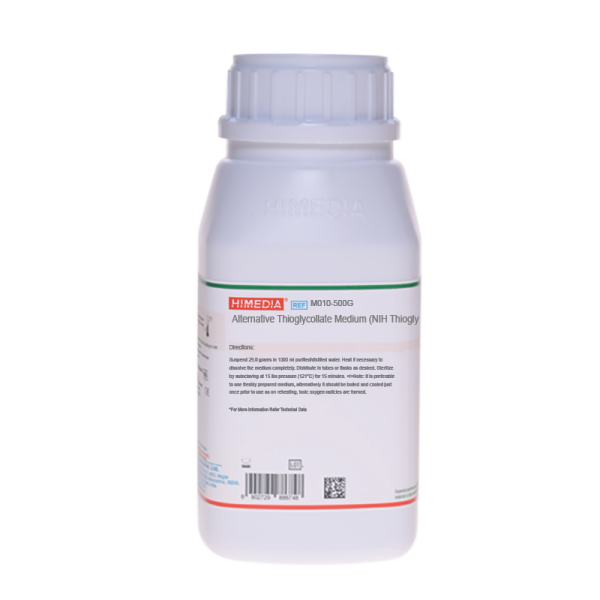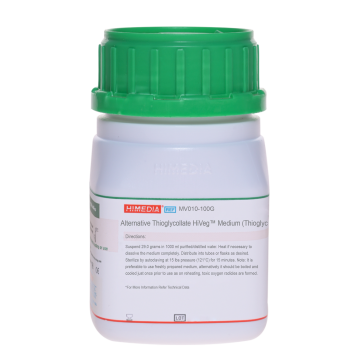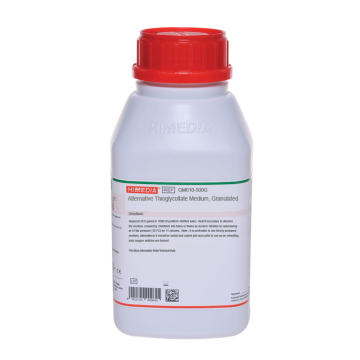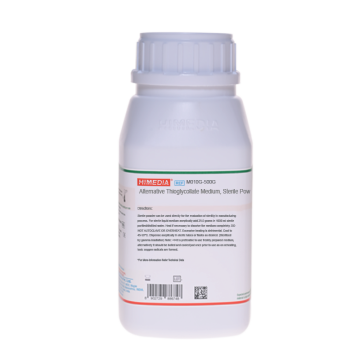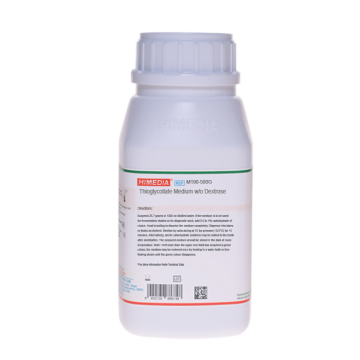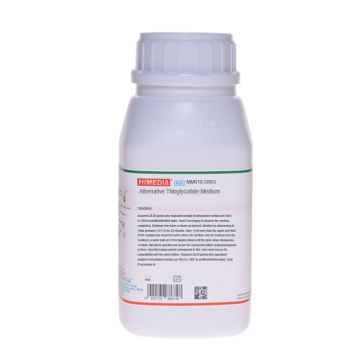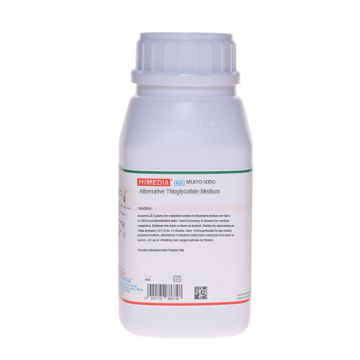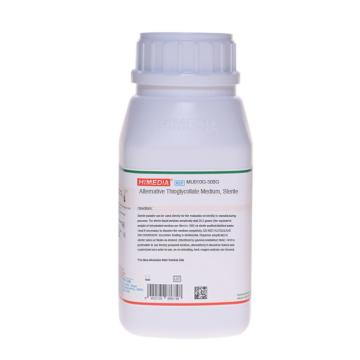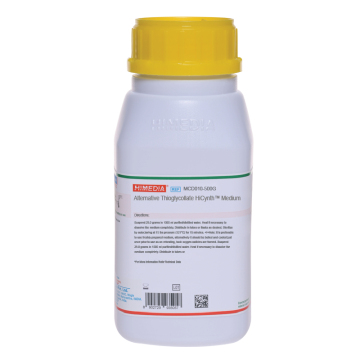 Your enquiry has been submitted
Your enquiry has been submitted
Alternative Thioglycollate Medium (NIH Thioglycollate Broth) (Thioglycollate Broth, Alternative)
Intended Use
Recommended for sterility testing of turbid or viscous biological product.
Composition
| Ingredients | g/L |
|---|---|
| Tryptone | 15.000 |
| Yeast extract | 5.000 |
| Dextrose (Glucose) | 5.500 |
| Sodium chloride | 2.500 |
| L-Cystine | 0.500 |
| Sodium thioglycollate | 0.500 |
| Final pH (at 25°C) | 7.1±0.2 |
Formula adjusted, standardized to suit performance parameters
Directions
Suspend 29.0 grams in 1000 ml purified / distilled water. Heat if necessary to dissolve the medium completely. Mix well and dispense into sterile tubes or flasks as desired. Sterilize by autoclaving at 15 lbs pressure (121°C) for 15 minutes.
Note: It is preferable to use freshly prepared medium, alternatively it should be boiled and cooled just once prior to use as on reheating, toxic oxygen radicles are formed.
Principle And Interpretation
Alternative Thioglycollate Medium is formulated as described in the N.I.H. memorandum (1). It is used for the sterility testing of certain biological products which are turbid or viscous and cant be tested using Fluid Thioglycollate Medium (M009)(2). Both the media have similar composition, except agar and resazurin that are not included in Alternative Thioglycollate Medium. This deletion makes it suitable for sterility testing of viscous products. Tryptone serves as a source of nitrogen and carbon compounds, long chain amino acids and other essential nutrients. Yeast extract serve as source of essential nutrients to the contaminants, if present. Dextrose serves as the energy source. Sodium chloride maintains the osmotic equilibrium of the medium whereas L-cystine, an amino acid, also serves as source of essential growth factors. Sodium thioglycollate and L-cystine lower the oxidation-reduction potential of the medium by removing oxygen to maintain a low Eh. Sodium thioglycollate also helps to neutralize the toxic effects of mercurial preservatives (3,4).
Type of specimen
Clinical: wound swabs, skin swabs or scrapings, tooth tartar etc. Pharmaceutical: Sterility testing of viscous products.
Specimen Collection and Handling
For clinical samples follow appropriate techniques for handling specimens as per established guidelines (5,6). For pharmaceutical products, follow appropriate techniques for sample processing in case of viscous materials as mentioned under sterility (7).
After use, contaminated materials must be sterilized by autoclaving before discarding.
Warning and Precautions
In Vitro diagnostic use. For professional use only. Read the label before opening the container. Wear protective gloves/protective clothing/eye protection/face protection. Follow good microbiological lab practices while handling specimens and culture. Standard precautions as per established guidelines should be followed while handling clinical specimens. Safety guidelines may be referred in individual safety data sheets.
Limitations
- Prior to use the medium should be boiled once to remove the absorbed oxygen and should not be reheated as frequent boiling leads to development of toxic products.
- The medium should not be used in fermentation process as medium contains yeast extract which is high in carbohydrate content.
- Biochemical test and serological procedures are required to confirm the findings.
Performance and Evaluation
Performance of the medium is expected when used as per the direction on the label within the expiry period when stored at recommended temperature.
Quality Control
Appearance: Cream to yellow homogeneous free flowing powder
Colour and Clarity of prepared medium: yellow coloured clear solution without any precipitate.
Reaction: Reaction of 2.9% w/v aqueous solution at 25°C. pH: 7.1±0.2
pH: 6.90-7.30
Cultural Response
Cultural characteristics observed after an incubation at 30-35°C for not more than 3 days.(*Incubated anaerobically).
| Organism | Inoculum (CFU) | Growth |
|---|---|---|
| *Clostridium sporogenes ATCC 19404 (00008*) | 50-100 | luxuriant |
| *Clostridium sporogenes ATCC 11437 | 50-100 | luxuriant |
| *Clostridium sporogenes NBRC 14293 | 50-100 | luxuriant |
| *Clostridium perfringens ATCC 13124 (00007*) | 50-100 | luxuriant |
| Staphylococcus aureus subsp. aureus ATCC 25923 (00034*) | 50-100 | luxuriant |
| Staphylococcus aureus subsp aureus ATCC 6538 (00032*) | 50-100 | luxuriant |
| Pseudomonas aeruginosa ATCC 27853 (00025*) | 50-100 | luxuriant |
| Pseudomonas aeruginosa ATCC 9027 (00026*) | 50-100 | luxuriant |
| Escherichia coli ATCC 25922 (00013*) | 50-100 | luxuriant |
| Escherichia coli ATCC 8739 (00012*) | 50-100 | luxuriant |
| Escherichia coli NCTC 9002 | 50-100 | luxuriant |
| Salmonella Abony NCTC 6017 (00029*) | 50-100 | luxuriant |
| Salmonella Typhimurium ATCC 14028 (00031*) | 50-100 | luxuriant |
| *Bacteroides fragilis ATCC 23745 | 50-100 | luxuriant |
| *Bacteroides vulgatus ATCC 8482 | 50-100 | luxuriant |
Key: (*) Corresponding WDCM numbers.
Storage and Shelf Life
Store between 10-30°C in tightly closed container and the prepared medium at 15-30°C. Use before expiry date on the label. On opening, product should be properly stored dry, after tightly capping the bottle inorder to prevent lump formation due to the hygroscopic nature of the product. Improper storage of the product may lead to lump formation. Store in dry ventilated area protected from extremes of temperature and sources of ignition Seal the container tightly after use. Product performance is best if used within stated expiry period.
Disposal
User must ensure safe disposal by autoclaving and/or incineration of used or unusable preparations of this product. Follow established laboratory procedures in disposing of infectious materials and material that comes into contact with clinical sample must be decontaminated and disposed of in accordance with current laboratory techniques (6,7).
Reference
- N.I.H. Memorandum, 1955: Culture Media for Sterility Tests, 4th Revision.
- Lapage S., Shelton J. and Mitchell T., 1970, Methods in Microbiology', Norris J. and Ribbons D., (Eds.), Vol. 3A, Academic Press, London.
- Nungester, Hood and Warren, 1943, Proc. Soc. Exp. Biol. Med., 52: 287
- Portwood, 1944, J. Bacteriol., 48: 255
- The United States Pharmacopoeia, 2020. The United States Pharmacopoeial Convention.Rockville, MD.
- Isenberg, H.D. Clinical Microbiology Procedures Handbook 2nd Edition.
- Jorgensen, J.H., Pfaller, M.A., Carroll, K.C., Funke, G., Landry, M.L., Richter, S.S and Warnock., D.W. (2015) Manual of Clinical Microbiology, 11th Edition. Vol. 1.
| Product Name | Alternative Thioglycollate Medium (NIH Thioglycollate Broth) (Thioglycollate Broth, Alternative) |
|---|---|
| SKU | M010 |
| Synonym | NIH Thioglycollate Broth |
| Product Type | Regular |
| Physical Form | Powder |
| Origin | Animal |
| Packaging type | HDPE |
| References | 1. N.I.H. Memorandum, 1955: Culture Media for Sterility Tests, 4th |
| Customized Product Available | No |



